Composition
by Michael Frye | Feb 8, 2015 | Composition
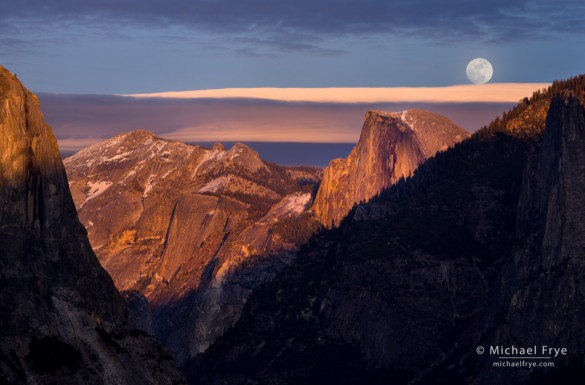
Moon rising above Half Dome from Tunnel View, Yosemite NP, CA, USA
During my workshop in Yosemite last week we photographed a spectacular moonrise on Monday evening from Tunnel View. A band of lenticular clouds hung in the sky in the distance, and just before the moon rose the sun broke through the clouds behind us and lit up El Capitan and Half Dome with vivid shades of orange.
In a recent interview I did for David Johnston and his Photography Roundtable podcast, we talked about using telephoto lenses for landscapes, and how using a longer lens is one way to simplify a composition. I use whatever lens seems appropriate for the situation – the lens that allows me to include all the essentials, but only the essentials. In the photograph above, that meant using my 70-200mm zoom at 183mm in order to fill the frame with the moon, Half Dome, that lenticular cloud, and the v-shaped notch below and to the left of Half Dome.
(more…)
by Michael Frye | Jan 11, 2015 | Composition, Vision and Creativity
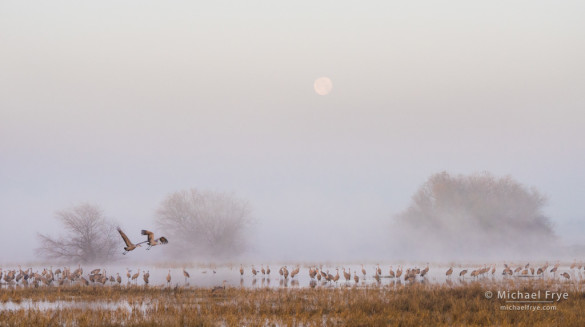
Sandhill cranes, fog, and the setting moon, San Joaquin Valley, CA
Although I specialize in photographing landscapes these days, I also enjoy photographing the masses of migrating birds that spend the winter in California’s Central Valley. And while I won’t pass up an opportunity to capture a close-up wildlife portrait, most of the time I’m trying to include some of the animals’ habitat. I’m really attempting to photograph landscapes with birds in them, and, as with other landscapes, use the light, weather, and moment to convey a mood.
Last Tuesday morning Claudia and I made another trip down to one of the wildlife refuges in the Central Valley. As usual, I hoped for fog, but knew that if the fog didn’t materialize there would be a nearly-full moon setting to the west, which also might help to add some mood to the photographs.
As it turned out, we got both. We found some low-lying mist, but it wasn’t thick enough to obscure the moon. I just needed some birds to add to the mix, and fortunately we found a flock of sandhill cranes roosting in a pond with the moon behind them.
(more…)
by Michael Frye | Dec 11, 2014 | Announcements, Composition, Vision and Creativity
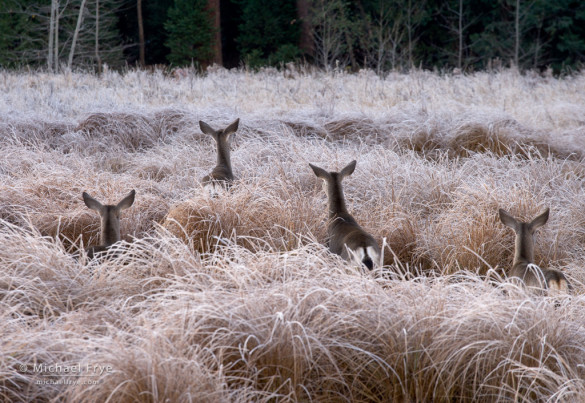
Curious deer, Yosemite
We all know that music has rhythm. Speech has rhythm too: the cadence of words, phrases, sentences, and paragraphs gives language its order and structure, and makes it easier to understand.
We don’t usually think of photographs as having rhythm, but they do – or, at least, good ones do. Most effective photographs have some kind of repetition, a pattern that helps give the image cohesion and rhythm.
The tenth issue of Photograph digital magazine just came out, and it includes an article of mine called “Finding Rhythm.” I’ve been thinking a lot about visual rhythm lately, so I was happy to have this opportunity to write about it for the magazine.
(more…)
by Michael Frye | Nov 21, 2014 | Composition, Vision and Creativity
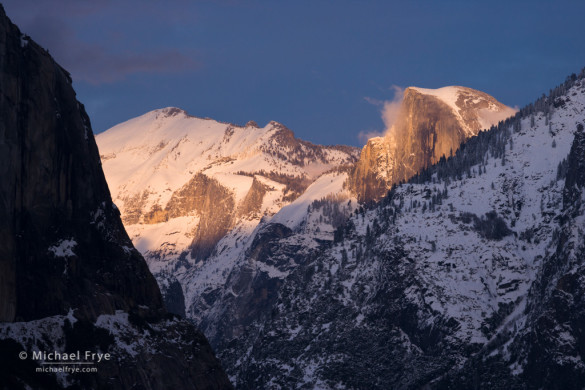
Half Dome at sunset from Tunnel View, Yosemite. The dramatic light might grab your attention here, but the interlocking diagonal lines create a cohesive design and a sense of energy.
One of the keys to learning composition is to think abstractly. As Ian Plant says in his excellent ebook about composition, Visual Flow, “Learning to think abstractly about visual elements is the single most important thing you can do to improve your compositional skills.” The less you think about the subject, and the more you think about the underlying abstract design – the lines, shapes, and patterns – the better your compositions will be.
It’s often easier to think abstractly when photographing a small subject, like a pattern of leaves, or a series of cracks in ice. But it’s just as important to look for repeating lines and shapes in big, sweeping landscapes. One of the most common – and powerful – designs in these big scenes is a series of interlocking diagonal lines. Most hilly or mountainous areas have an abundance of diagonals, and diagonal lines give a photograph a sense of dynamic energy and motion – a perfect fit for dramatic landscape images.
(more…)
by Michael Frye | Nov 13, 2014 | Composition, Light and Weather, Vision and Creativity
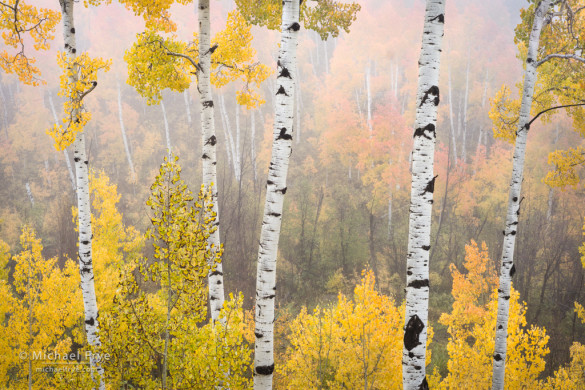
Aspens in fog near Ridgway, CO
Claudia and I have been busy since our trip to Colorado in early October, so I haven’t had a chance to post more images from our travels until now. But maybe that’s a good thing, as that time has given me a chance to reflect on the journey.
It had been a dream of mine to photograph the autumn aspen display in Colorado, and it more than lived up to my expectations. Colorado veterans said it was the best fall there in many years, and it certainly looked good to us. The sheer number of aspens covering the hillsides was astonishing.
The problem was that I didn’t know the area. At all. I’m usually writing about photographing Yosemite, or maybe the aspens on the eastern side of the Sierra, places that I know intimately. That knowledge is a big advantage, giving me a greater chance of being in the right place at the right time to take advantage of the light, weather, and conditions.
(more…)
by Michael Frye | Aug 6, 2014 | Composition, Vision and Creativity
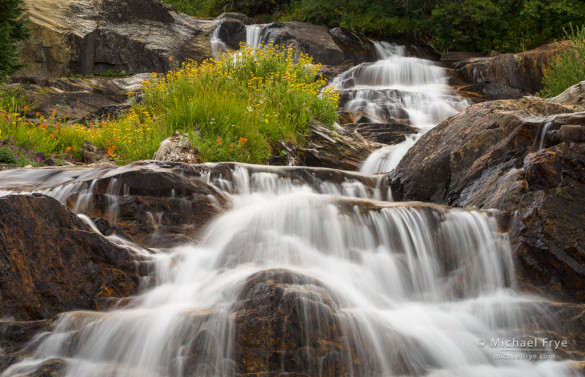
Wildflower island and cascade, eastern Sierra; 100mm, 1/2 sec. at f/16, 100 ISO
It’s been an interesting summer in the Sierra. Last winter was one of the driest on record, but over the last month or so we’ve seen a steady flow of monsoonal moisture flowing up from the southeast, leading to frequent afternoon showers and thunderstorms over the higher elevations. We even heard about an epic deluge two or three weeks ago that flooded the parking lot and some of the tent cabins at the Tuolumne Meadows Lodge.
That extra moisture has kept the streams flowing and flowers blooming in the high country longer than I would have expected. On Saturday Claudia and I hiked up one of the eastern Sierra canyons and found a pretty series of cascades, with an island of late-summer flowers in the middle.
Although I make my share of black-and-white photographs, I’ve always been attracted to color. I often look for color, then try to build a composition around it. As I tell my workshop students, color isn’t enough – you need to find a design to go with that color.
In this case, that design proved to be elusive. The most obvious composition was a wide-angle view with a patch of flowers at the bottom, and the upper cascade above. But there was a distracting pile of logs at the base of the cascade that cluttered the image, with no obvious way to eliminate or minimize the logs. I have nothing against logs, but in this case I was interested in the flowers and water, and the logs broke up the visual flow between the flowers and water, diluting the photograph’s message:
(more…)














